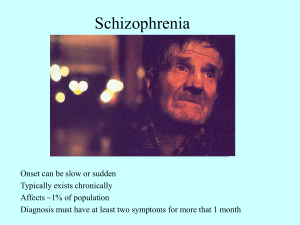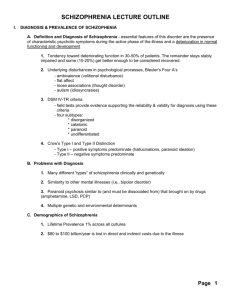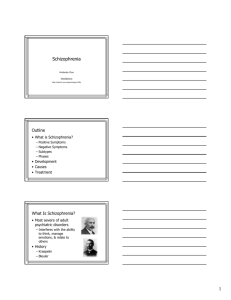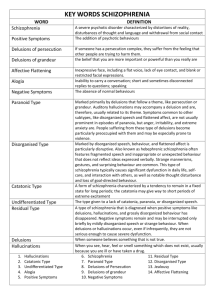File - Rose's e
advertisement
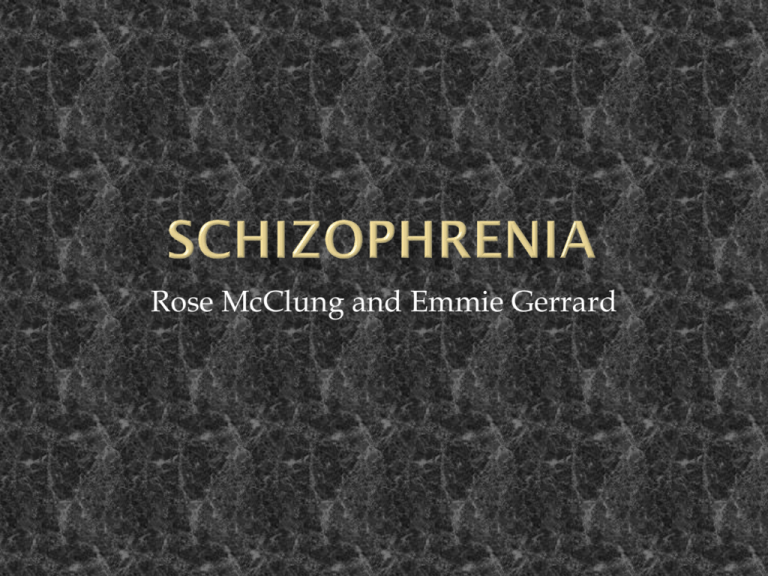
Rose McClung and Emmie Gerrard Schizophrenia is a disorder of the brain which may cause severe symptoms. Most cases of schizophrenia are life-long, difficult to manage, and can affect many areas of a person's life. A form of schizophrenia characterized by a tendency to remain in a fixed stupor state for long periods. The catatonia may give way to short bursts of extreme excitement or hyperactive tendencies. Catatonic episodes may last for a month or longer if not treated. Physical immobility (including speaking), or "waxy flexibility" (if your arm is moved, it will stay in that position for several hours) Excessive mobility (moving in an excited manner that seems to have no purpose) Extreme resistance (not responding to instructions, refusing to be moved, refusing to speak) Peculiar movements (inappropriate or peculiar postures, grimace for long periods of time, use strange mannerisms, may also mechanically repeat certain behaviors such as repeating words, obsessively following routines, or always arranging objects in certain ways) Mimicking speech or movement Disorganized schizophrenia is also known as hebephrenic schizophrenia. It is considered one of the most severe types of schizophrenia because it can severely disrupt normal functioning of daily life activities. Disorganized thinking and behavior Absent or inappropriate emotional responses Delusions Auditory and visual hallucinations Grimacing Odd postures Trouble functioning at school or work Social isolation Clumsy, uncoordinated movements Suicidal thoughts Key differences between Paranoid Schizophrenia and the other types are harmful delusions and extremely negative auditory hallucinations. Paranoid schizophrenics are less likely to be affected by problems with thinking, concentration, and mood. Auditory hallucinations Delusions Anxiety Anger Emotional distance Violence Argumentativeness Self-important or condescending manner Suicidal thoughts and behavior When a person has a history of schizophrenic symptoms, but none of his/her current symptoms match previously diagnosed symptoms. At least one year must have passed since symptoms of previously-diagnosed schizophrenia minimized or substantially reduced before residual schizophrenia can be diagnosed. Psychomotor slowing Lack of physical activity Passivity and lack of initiative Inability or refusal to speak Lack of personal care Poor social performance Undifferentiated Schizophrenics have the characteristic symptoms of schizophrenia but do not meet the specific criteria for the paranoid, disorganized, catatonic, or residual types. A person with Undifferentiated Schizophrenia must have at least two of the following symptoms: Delusions Hallucinations Disorganized speech Extremely disorganized or catatonic behavior Genetics and environment are both involved Exposure to viruses while in the womb Poor nutrition while in the womb Stressful life circumstances Taking psychoactive drugs, especially during adolescence Treatment usually involves a combination of psychiatry and medication usage. Often there are treatment “teams” which can include: a doctor, psychiatrist, case worker, psychiatric nurse, psychotherapist, pharmacist, family members, social workers. Individual and Family Therapy There are two types of medications: First-generation (typical) antipsychotics: control symptoms by affecting neurotransmitters. They attempt to manage delusions and hallucinations. However, they do have frequent and possibly severe side effects, including involuntary muscle spasms. Second-generation (atypical) antipsychotics: These are newer antipsychotic medications and target hallucinations, delusions, loss of motivation and lack of emotion. These have metabolic side effects, including weight gain, diabetes and high cholesterol. Haloperidol (Haldol) Droperidol (Inapsine) Chlorpromazine (Thorazine) Fluphenazine (Prolixin) Trifluoperazine (Stelazine) Perphenazine (Trilafon) Thioridazine (Mellaril) Thiothixene (Navane) Molindone (Moban) Loxapine (Loxitane) Hospitalization: in extreme cases where the person suffering from schizophrenia is harmful to themselves or others, this ensures safety, proper nutrition and care. Electroconvulsive therapy (ECT): causes a small seizure which can change the chemistry of the brain chemistry to reduce symptoms. Vocational skills training: Training in social and vocational skills, such as learning skills like good hygiene, cooking and better communication. Schizophrenia is in the top 10 causes of disability in developed countries worldwide, with about 51 million people diagnosed and 2.2 million of those people living in the USA. If anti-psychotic medications use is discontinued, the relapse rate is about 80 percent within 2 years. Of those diagnosed with schizophrenia: 6% are homeless or live in shelters 6% live in jails or prisons 5% to 6% live in hospitals 10% live in nursing homes 25% live with a family member 28% are living independently 20% live in supervised housing Schizophrenia, though often severe and hard to cope with, is a treatable disorder of the brain. Those with schizophrenia may live with their treatments for their entire lives. How might schizophrenia affect a person's life? Surviving Schizophrenia : A Manual for Families, Patients, and Providers (5th Edition) by E. Fuller Torrey http://www.mayoclinic.com http://www.cnn.com/HEALTH/library/disorganizedschizophrenia/DS00864.html http://www.medicalnewstoday.com/articles/192621.php http://www.mayoclinic.com/health/paranoidschizophrenia/DS00862/DSECTION=treatments-and-drugs http://medicaldictionary.thefreedictionary.com/undifferentiated+schizophrenia http://psychcentral.com/lib/2006/undifferentiated-schizophrenia/ http://www.schizophrenic.com/content/schizophrenia/diagnosis/undi fferentiated-schizophrenia http://www.freemd.com/undifferentiated-schizophrenia/treatment.htm http://www.mayoclinic.com/health/catatonicschizophrenia/DS00963/DSECTION=symptoms http://www.psychcentral.com/lib/2006/residual-schizophrenia/

